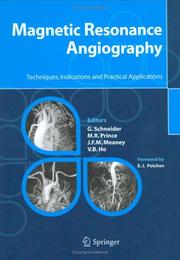| Listing 1 - 4 of 4 |
Sort by
|
Book
ISBN: 9783540745044 9783540745013 Year: 2010 Publisher: Berlin Heidelberg Springer Berlin Heidelberg
Abstract | Keywords | Export | Availability | Bookmark
 Loading...
Loading...Choose an application
- Reference Manager
- EndNote
- RefWorks (Direct export to RefWorks)
Magnetic resonance imaging (MRI) has become the leading cross-sectional imaging method in clinical practice. Continuous technical improvements have significantly broadened the scope of applications. At present, MR imaging is not only the most important diagnostic technique in neuroradiology and musculoskeletal radiology, but has also become an invaluable diagnostic tool for abdominal, pelvic, cardiac, breast and vascular imaging. This book offers practical guidelines for performing efficient and cost-effective MRI examinations in daily practice. The underlying idea is that, by adopting a practical protocol-based approach, the work-flow in a MRI unit can be streamlined and optimized.
Medicine & Public Health. --- Imaging / Radiology. --- Neuroradiology. --- Pediatrics. --- Medicine. --- Medical radiology --- Pediatrics. --- Médecine --- Radiologie médicale --- Pédiatrie

ISBN: 9788847002661 9788847003521 Year: 2005 Publisher: Milano Springer Milan
Abstract | Keywords | Export | Availability | Bookmark
 Loading...
Loading...Choose an application
- Reference Manager
- EndNote
- RefWorks (Direct export to RefWorks)
The advent of contrast-enhanced MRA in the early to mid 1990s revolutionized the clinical approach to vascular imaging: an accurate non-invasive imaging modality, not requiring ionizing radiation or potentially nephrotoxic iodinated contrast media, was able to compete with the more hazardous and invasive catheter angiography. Today, MRA is a safe, easy-to-perform procedure routinely used in most imaging centers, and the continued development of faster, more powerful magnets and more effective contrast agents is increasingly helping to overcome many of the early limitations of the technique. Subdivided into three sections (technique, indications and practical applications) and written by internationally renowned experts in the field, this volume stands out in the current literature on MRA by providing: - detailed information on sequence parameters for different magnets and vascular territories for the optimization of the MRA technique; - a broad overview of the principal indications for which contrast-enhanced MR angiography is ideally suited; - the typical MR imaging findings associated with various pathologies; - the appropriateness of contrast-enhanced MRA as compared with other modalities, such as CTA and CEUS; - the potential pitfalls and limitations of the technique in clinical routine. The volume will prove invaluable to radiologists and clinicians wishing to expand, improve, or consolidate their routine approach to vascular MR imaging.
Digital
ISBN: 9788847003521 Year: 2005 Publisher: Milano Springer-Verlag Italia
Abstract | Keywords | Export | Availability | Bookmark
 Loading...
Loading...Choose an application
- Reference Manager
- EndNote
- RefWorks (Direct export to RefWorks)
Blood physiology. Circulatory physiology --- Physical methods for diagnosis --- Pathology of the circulatory system --- cardiologie --- bloedsomloop --- lymfevaten --- radiologie --- medische beeldvorming
Digital
ISBN: 9783540745044 9783540868569 9783540745013 9783662495988 Year: 2010 Publisher: Berlin, Heidelberg Springer
Abstract | Keywords | Export | Availability | Bookmark
 Loading...
Loading...Choose an application
- Reference Manager
- EndNote
- RefWorks (Direct export to RefWorks)
Magnetic resonance imaging (MRI) has become the leading cross-sectional imaging method in clinical practice. Continuous technical improvements have significantly broadened the scope of applications. At present, MR imaging is not only the most important diagnostic technique in neuroradiology and musculoskeletal radiology, but has also become an invaluable diagnostic tool for abdominal, pelvic, cardiac, breast and vascular imaging. This book offers practical guidelines for performing efficient and cost-effective MRI examinations in daily practice. The underlying idea is that, by adopting a practical protocol-based approach, the work-flow in a MRI unit can be streamlined and optimized.
Radiotherapy. Isotope therapy --- Paediatrics --- Physical methods for diagnosis --- Neuropathology --- neurologie --- pediatrie --- radiologie --- medische beeldvorming
| Listing 1 - 4 of 4 |
Sort by
|

 Search
Search Feedback
Feedback About UniCat
About UniCat  Help
Help News
News